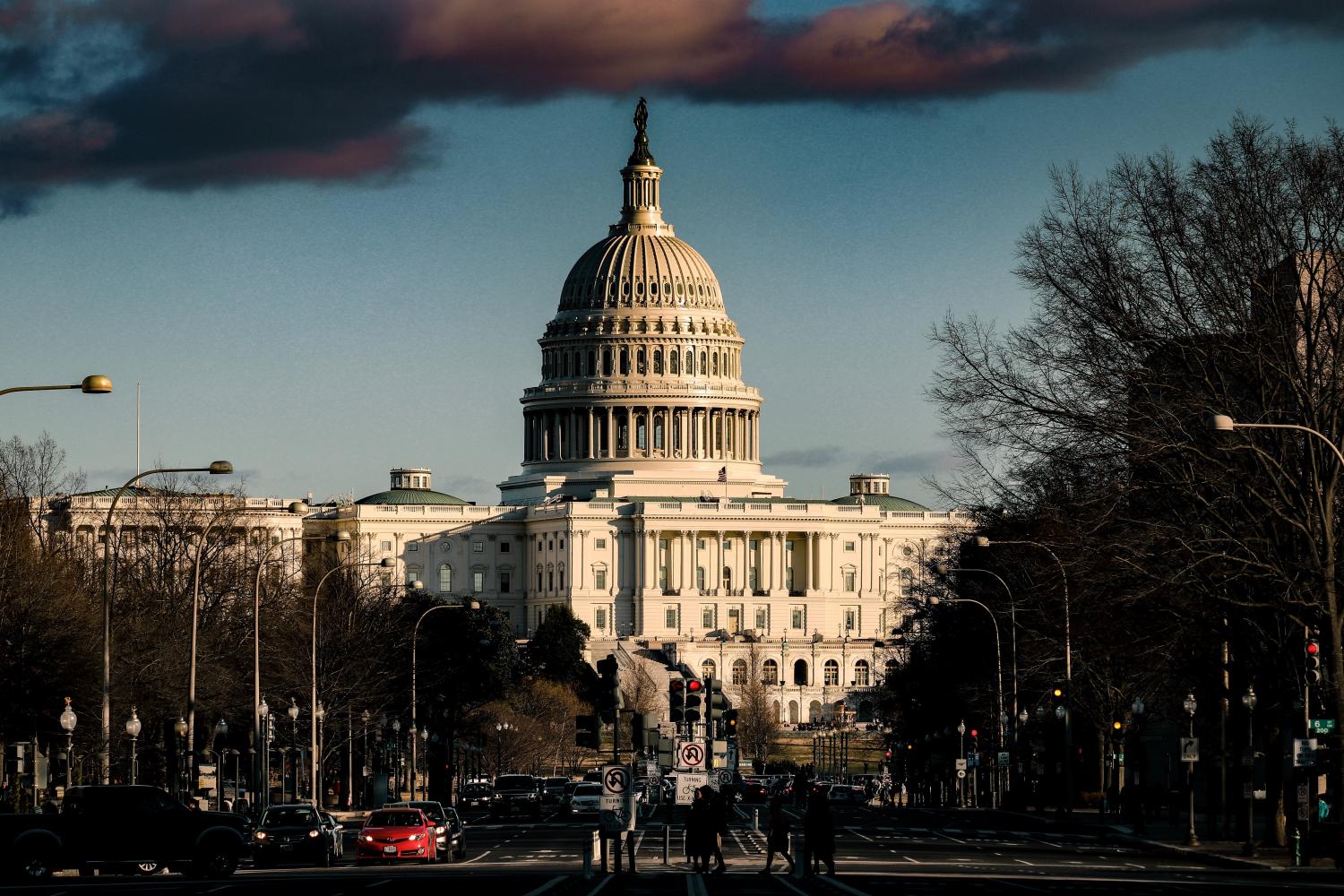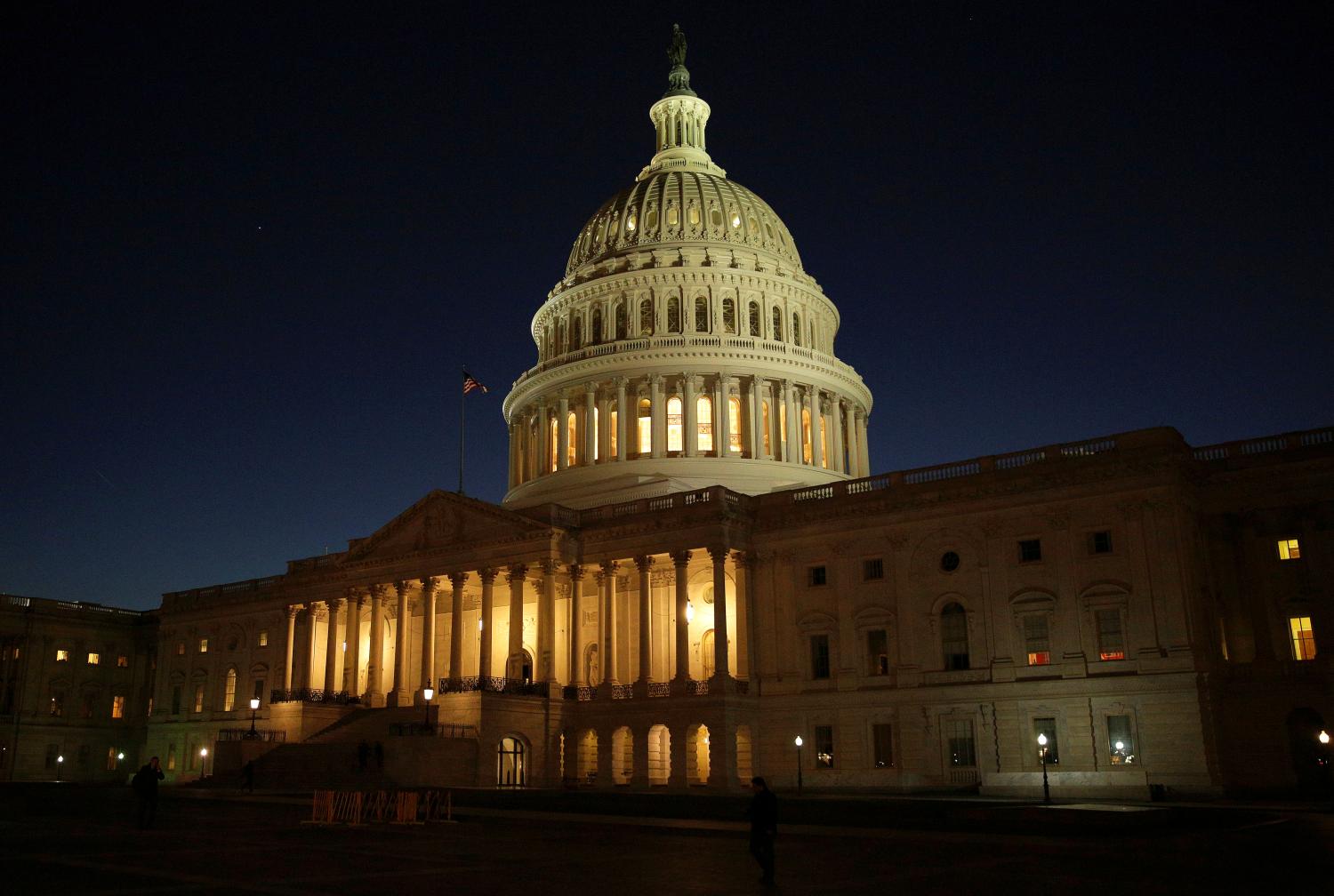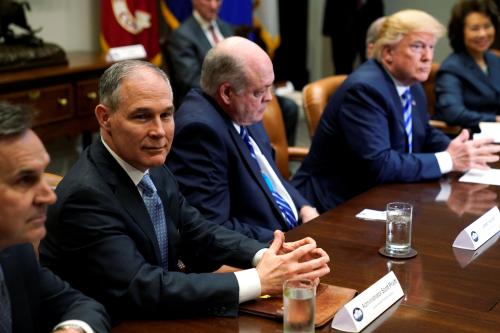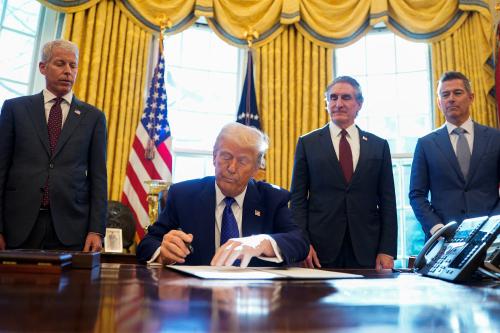This report is part of the Series on Regulatory Process and Perspective and was produced by the Brookings Center on Regulation and Markets.
On March 15, President Trump issued his first veto. Congress had passed a joint resolution of disapproval of his declaration of a national emergency at the southern border, using the procedures prescribed by the National Emergencies Act. Trump, however, was determined to secure funding for his wall, and the vote totals in the House (245-182) and Senate (59-41) showed that there was no serious possibility of a veto override, which requires a two-thirds supermajority in each house. Litigation may slow Trump, but not Congress.
A similar story played out a month later. On April 16, Trump vetoed a joint congressional resolution invoking the War Powers Act to limit U.S. involvement in Yemen’s civil war, which the House had passed 247-175 and the Senate 54-46. Again, Congress had sought to use a statute originally designed to limit the president’s unilateral power—but, again, it had merely shown its relative weakness, with Trump’s policy prevailing thanks to the veto.
In this piece, I argue that regulatory politics have a good deal to do with Trump’s victory in both of these decidedly non-regulatory matters. By creating a strong political association between provisions to empower Congress and the cause of cutting back on regulations, Republicans in Congress have made it significantly harder to fashion bipartisan compromises that favor the first branch. To make that case, I need to first review some history.
The replaceable, but unreplaced, legislative veto
You might well ask: Why would Congress have structured the War Powers Act and National Emergencies Act so as to make itself so ill-equipped to contend with the president? Couldn’t legislators understand that the presidential veto would render their joint resolutions impotent in all but the most extraordinary cases?
In fact, Congress did not structure either law so carelessly. In both cases, when it enacted the laws (1973 and 1976, respectively) legislators gave themselves the power to counteract a presidential action through a concurrent resolution—i.e., a joint action that did not require the president’s signature to become effective, often referred to as a legislative veto. If Congress were still in the business of passing effective concurrent resolutions today, Trump’s border emergency and U.S. involvement in Yemen would both be terminated as a result of the majority votes in the House and Senate. There would be no place for a presidential veto.
Congress no longer takes such actions because of INS v. Chadha, the 1983 case in which the Supreme Court, by a vote of 8-1, ruled that legislative vetoes were unconstitutional because of their inconsistency with the Constitution’s requirement of presentment.[1] All legislative actions must be presented to the president and secure his signature, or else follow the prescribed veto override procedure, the Court ruled, thereby invalidating nearly 200 statutory provisions for legislative vetoes scattered throughout the U.S. Code. Only Associate Justice Byron White dissented, presciently worrying that the Court’s formalist zeal was leading it to seriously disrupt the balance between the legislative and executive branches negotiated over the course of decades.
INS v. Chadha is hardly news—indeed, it was handed down nearly a lifetime ago for most Americans. Congress has had lots of time to adapt to life without the legislative veto. Over the course of the 1980s, it sometimes was able to fashion informal substitutes. In other cases, including the National Emergencies Act, it substituted joint resolutions of disapproval (requiring presidential signatures) for earlier legislative vetoes.
After Republicans retook Congress in 1995, they also passed the Congressional Review Act (CRA) as a piece of their Contract with American Advancement Act of 1996. The CRA requires that government agencies report all rules to Congress, which then has 60 legislative days to pass a joint resolution of disapproval that will render the rule ineffective and prevent the agency from promulgating another “substantially similar” rule. Once again, however, the presidential veto is in play. As a result, almost all successful disapprovals of rules under the CRA have occurred in the immediate wake of a party change in the White House.[2] Under normal circumstances, when presidents are able to protect their administrative agencies’ decisions with a veto, the CRA has little impact.
There were other ways to fill the gap left by Chadha. Rather than turning to joint resolutions of disapproval, Congress might have chosen to engineer processes by which some presidential actions would have to win congressional backing to become effective, or permanent. In other words, whereas the legislative veto once gave Congress a chance to red-light some actions (and joint resolutions of disapproval do the same, but subject to a veto), one could create a system in which a president must get a congressional greenlight to establish some action as law. As Stephen Breyer, then a circuit court judge, wrote in response to Chadha, such a system would be constitutional, as it would deploy the normal requirements of bicameralism and presentment.
The ambitions of REINS
Republicans began pursuing such a system after the election of Barack Obama in 2008. In October 2009, Rep. Geoff Davis (R-Kentucky) introduced the Regulations from the Executive In Need of Scrutiny (REINS) Act in the House, eventually getting 84 GOP cosponsors to sign on. Senator Jim DeMint (R-South Carolina) introduced an identical bill in the Senate in 2010, getting 13 cosponsors.
Exempting only monetary policy decisions, the REINS Act would require every significant rulemaking to be presented to Congress for its approval. Procedural provisions in the law would virtually guarantee that each house of Congress would have to take a vote on the merits within a relatively short period of time, thereby ensuring that congressional inaction could not be used to stall legislation. Indeed, Davis and other supporters of the bill argued that the REINS Act was all about getting Congress to take an appropriate degree of responsibility for the manifold rules coming out of the regulatory agencies, rather than just acting like a critical but helpless bystander.
With Democrats in control of both Congress and the White House, the REINS Act predictably received little attention during the 111th Congress. But after Republicans won control of the House in 2010, REINS seemed to have real chances—at least of making it out of the House. The Democratic Senate would be unlikely to pass it, but Republican legislators would nevertheless love to be in a position to say that they were in favor of making Congress accountable for regulations’ impact on America’s then-suffering economy, with only Democrats standing in their way.
Once again introduced by Davis in January 2011 (and in the Senate by Rand Paul, also of Kentucky, in February), the REINS Act worked its way through the House Judiciary and Rules committees, each of which reported it favorably. REINS was presented as “the latest chapter in Congress’ struggle to hold regulatory agencies accountable to the public,” especially in response to INS v. Chadha. Whereas the CRA lacked teeth, REINS would be effective.
Beyond the theme of accountability, though, the rhetoric in support of REINS was sharply anti-regulatory. Republicans’ message was that over-regulation was stifling Americans’ economic dynamism, but if Republican legislators had a more effective say in the regulatory process they would ensure that future regulations would have a lighter touch. Democrats were comfortable joining this familiar war of words over the merits of regulation. Their Minority Report declared: “By requiring Congressional approval of major rules, H.R. 10 would serve as a procedural ‘chokehold’ in multiple ways on Federal agency rulemaking and undermine the ability of agencies to provide essential protections to Americans. This legislation is a thinly disguised attempt to prevent the implementation of critical laws, such as the [Affordable Care Act] and Dodd-Frank.”
Given this familiar partisan fight about regulation, REINS received a largely party-line vote in the House in December 2011. It passed 241-184, including four Democratic “aye” votes. Predictably, it never made it out of the Democratic Senate. Standing on its own, the REINS Act had 31 cosponsors, including lone Democrat Joe Manchin (West Virginia), but it never received committee attention. The bill’s language was also included as a part of the Jobs Through Growth Act, which had 37 cosponsors but never advanced, and the Long-Term Surface Transportation Extension Act of 2011, which got as far as a motion to proceed in November 2011, failing 47-53, with Manchin voting with Republicans and Senator Olympia Snowe (R-Maine) voting with Democrats.
With the same political configuration in place after Barack Obama’s reelection, the 113th Congress treated REINS similarly to its predecessor. The House Judiciary Committee reported out the bill, now sponsored by Rep. Todd Young (R-Indiana), in July 2013. It was brought to the House floor in August. Republican members passed a few marginal amendments stiffening agency reporting requirements and including a requirement for job impact estimates as part of cost estimates. Democrats failed to pass amendments exempting various kinds of amendments. In general, the floor debate centered squarely on “regulation bad” versus “regulation good.” The vote for passage was 232-183, with 6 Democrats joining the GOP majority. REINS was also included in the Jobs for America Act, which packaged together a large number of pro-business policies and passed 253-163, with 32 Democratic “aye” votes. The Senate, however, took no action at all on REINS.
Republican congresses drop the REINS
In the 114th Congress, Mitch McConnell (R-Kentucky) replaced Harry Reid (D-Nevada) as Senate Majority Leader, seemingly increasing the prospects of getting the REINS Act at least as far as the President’s desk. With no new hearings, the House Judiciary Committee reported the bill again, and in July 2015, the House passed REINS 243-165, this time with just two Democratic “aye” votes. In the Senate, REINS eventually got 36 cosponsors, all Republicans. But, in spite of Republicans’ control of the chamber, it never received any committee attention or made any progress toward passage. Perhaps that was because its backers expected it to run into a filibuster, or perhaps because they saw forcing a veto as fruitless, but in any case the Senate’s inaction raised doubts about how serious Republicans were in seeking passage of REINS.
Finally, in the 115th Congress, Republicans achieved unified control of the House, Senate, and White House. President Donald Trump styled himself as a staunch opponent of overregulation, setting in motion an executive-branch centered regulatory budget policy as soon as he took office in January 2017. Could Republicans bring any Democrats into their camp to pass REINS, seemingly a necessity to count to 60 votes in the Senate?
Rep. Doug Collins (R-Georgia), who had become the bill’s lead sponsor after Young’s election to the Senate, sought to reassure skeptics of the bill. On January 4, 2017, he made the case for his bill in the Heritage Foundation’s Daily Signal website. He noted: “The bill is not retroactive, so Republicans haven’t devised it as a way to blot out the actions of a previous administration and the agencies it oversaw. It’s also not unwieldy from a legislative perspective, adding only 50-100 votes to the congressional calendar each year.” In other words: Democrats could support the bill now that Obama’s regulations were ensconced, and it would be the Trump administration’s rules being held accountable.
The next day, Republicans took up the REINS Act for consideration on the House floor, bypassing the committee process—a choice that seems not entirely unreasonable, given the familiarity of the chamber with the bill it had passed in each of the previous three congresses. But this time two major substantive amendments were added to REINS on near-party-line votes, neither of which were subjected to extended debate. The first was a “Regulatory cut-go government” meant to parallel the actions being taken by the Trump administration, which would require that agencies find old regulations to cut in order to be able to promulgate new regulations. The second, offered by Rep. Steve King (R-Iowa), was entitled, “Review of rules currently in effect.” It would ask Congress to vote to affirm every part of the existing Code of Federal Regulations within 10 years of passage. Whatever Congress did not take up would automatically cease to be effective at that time. Having just told the world that REINS was not designed to reach old rules, Collins (and all but four other House Republicans present) voted to add amendments that did precisely that.
This does not seem like the behavior of legislators determined to forge a bipartisan consensus. Predictably, advocacy groups on the left denounced the bill as part of a corporate-sponsored assault on necessary and beneficial regulatory protections. But they were not the only ones turning on the bill as amended. Professor David Schoenbrod of New York Law School, who had been one of the witnesses called by Republicans to testify in favor of REINS in 2011, argues that the requirement to vet all existing regulations ought to be understood as a “poison pill” ensuring that the bill will never get a real chance of passage. As a result, he has come to regard REINS as a sort of hoax, meant to dupe voters into thinking that Republican legislators want to exercise responsibility while actually ensuring they have to do no such thing.
Whether or not that accurately captures Republican motives, there is no question that the push to secure bipartisan support for REINS in the Trump administration never happened. The House passed its amended version, 237-187, again with two Democrats crossing the aisle. The Senate’s Committee on Homeland Security and Governmental Affairs reported the unamended version of the bill in October 2017, but no further action was ever taken. It got 39 cosponsors, all Republicans.
With Democrats back in control of the 116th Congress, the prospects for moving REINS in either chamber now look dim. Indeed, no Republican member in the House has bothered to introduce a new version of the REINS Act yet. Senator Paul has again introduced REINS in the Senate, where it currently has 39 cosponsors—meaning that 14 Republicans aren’t signing on. In other words, even if Republicans abolished the filibuster, REINS’ chances in the Senate would not be good.
The legacy of REINS, and beyond
It seems clear at this point that, at least in its incarnation of the 2010s, the REINS Act is never going to restructure our regulatory process. Perhaps it could be altered to make it less unwieldy, as I suggested in a 2014 Brookings paper, or perhaps it is best left to historical interest at this point, an acronym for the ages.
But the question of how the legislature can structure policymaking processes so as to ensure its own influence is a permanent one in our constitutional system, and indeed has received considerable attention in the last several years. These debates show the wide impact of REINS, and also suggest why advocates of congressional reengagement must move beyond it.
Most notable is an episode that played out during the debates over the National Defense Authorization Act for Fiscal Year 2019, which eventually became law in August 2018. Senator Pat Toomey (R-Penn.) was concerned by decisions being made by the Committee on Foreign Investment in the United States (CFIUS), which had been blocking various investments on the grounds of national security. Toomey argued that balancing safety against the risks of chilling direct foreign investment was an inherently political decision, best handled by Congress, and offered an amendment that would have forced all such decisions to be sent to Congress before they could become effective. Eventually, Toomey managed to secure a vote on his amendment, which failed to secure cloture 35-62.
All Democrats voted against Toomey’s amendment. One reason may well have been the branding: Toomey’s office publicized their effort as “REINS for Foreign Investment Reviews” and got the Wall Street Journal’s support for it in that way. But while “Uber for X” may be a good sales pitch, that is because Uber has marketed a fantastically successful product. “REINS for X” does not have that same advantage—instead, it calls to mind a bitterly partisan fight over whether we should have any regulations. For those seeking to promote Congress’s institutional prerogatives, which ought to be a bipartisan project, some other appeal is needed.
The congressional greenlight framework has also been suggested in the context of trade decisions. Senator Mike Lee (R-Utah), who is among the most relentless advocates for a stronger first branch of government, recently argued that such a framework should replace the existing National Emergencies Act, such that the president could only take actions for 30 days without receiving the affirmative support of Congress. In 2017, Lee also introduced the Global Trade Accountability Act, which would have forced all presidential decisions to raise tariffs to run through Congress. Senator Toomey has taken that idea but narrowed it with the Bicameral Congressional Trade Authority Act, which would require congressional approval for all tariff increases proposed by the president on grounds of national security.
For Lee and Toomey, among others, optimism about passing REINS remains the official position. That threatens the ability to form bipartisan coalitions in favor of congressional accountability on these non-regulatory matters—which is especially unfortunate given that there are signs that such ideas have support in left-of-center legal circles.
But it also effectively prevents the formulation of a more realistic plan to make Congress an active decision-maker on the most important regulatory matters. That ultimately impairs the legitimacy of the administrative state. If that sounds like a rather abstract or speculative concern, it also destroys policymakers’ ability to do their jobs effectively. Designing a program to do something as complicated as regulating nationwide greenhouse gas emissions from power plants or ensuring the water quality of all navigable streams is hard enough on its own terms, but making a plan that will stick in the context of a hostile Congress is nearly impossible for regulators operating on their own. Their carefully wrought plans end up bogged down in court and threatened with reversal at the next change of party in the White House. Forcing both parties to actively take up such blockbuster regulatory issues on the front end, through a congressional greenlight policy for the most important regulatory choices, would drastically improve our ability to make politically sustainable policies. REINS did not turn out to bring us such a system. Future Congresses should begin a new “chapter in Congress’ struggle to hold regulatory agencies accountable to the public” to try to get one.
Philip Wallach is a senior fellow in the governance project at the R Street Institute. The author did not receive financial support from any firm or person for this article or from any firm or person with a financial or political interest in this article. He is currently not an officer, director, or board member of any organization with an interest in this article.
The Brookings Institution is committed to quality, independence, and impact.
We are supported by a diverse array of funders. In line with our values and policies, each Brookings publication represents the sole views of its author(s).






